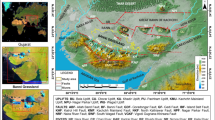Abstract
The Barak Valley, comprising a contiguous region of three south Assam districts of Cachar, Hailakandi and Karimganj, represents a ridge and valley province with meridional to sub-meridional anticlinal hills and synclinal valleys. Thin skinned tectonics resulted in the deformation of Neogene clastics which is manifested in the form of a series of anticlines and synclines. These structural elements have profound control on the development of present-day landscape in Barak valley. Structurally controlled fluvial erosion produced a series of cuesta ridges and strike valleys which were further subjected to erosional dissection leading to development of numerous topographic highs. Along the northern part of Barak valley adjoining Barail range, three terrace levels stand out with topographic offsets of upto ∼10 m. These terraces are linked to tectonic adjustments along Haflong-Disang Thrust that traverse along the Barail foothills. Numerous wetlands linked to fluvial activities and also isolated from the fluvial domain form a significant element of the Barak valley landscape. Some of these wetlands have their origin to tectonic activities of the region. While the trunk channel of the region follows a nearly E-W trend, all the major tributaries join it at nearly orthogonal position following the prevailing structural trend.
Similar content being viewed by others
References
Bissig, T., Clark, A.H., Lee, J.K.W. and Hodgson, C.J. (2002) Miocene landscape evolution and geomorphic control on epithermal processes in the Al-India-Pascua Au-Ag-Cu belt, Chile and Argentina, Econ. Geol., v.97, pp.971–996.
Brunnschweiler, R.O. (1966) On the geology of the Indo-Burma Ranges. Jour. Geol. Soc. Australia, v.13(1), pp.137–194.
Burberry, C.M., Cosgrove, J. W. and Liu, J-G. (2008) Spatial arrangement of fold types in the Zagros Simply Folded Belt, Iran, indicated by landform morphology and drainage pattern characteristics. Jour. Maps, pp.417–430, doi: 10.4113/jom.2008.97.
Clark, G.M. and Ciolkosz, E.J. (1988) Periglacial geomorphology of the Appalachian Highlands and Interior Highlands south of the glacial border — a review. Geomorphology, v.1, pp.191–220.
Das Gupta, A.B. and Biswas, A.K. (2000) Geology of Assam. Geological Society of India, Bangalore, pp.1–169.
Desikachar, S.V. (1974) A review of the tectonic and geologic history of Eastern India in terms of plate tectonic theory. Jour. Geol. Soc. India, v.15(2), pp.137–149.
Dutta, T.K. and Saikia, M.M. (1976) The eastern limit of the Himalayan Orogenic Belt — the Indo-Burman Orogen and its geodynamic development. Hins. Geol., v.6, pp.303–313
Evans, P. (1932) Tertiary succession in Assam. Trans. Min. Geol. Inst. India, v.27, pp.155–260.
Evans, P. (1964) Tectonic framework of Assam. Jour. Geol. Soc. India, v.5, pp.80–96.
Ganguly, S. (1975) Tectonic evolution of Mizo Hills. Bull. Geol. Min. Met. Soc. India, v.48, pp.29–39.
Ganguly, S. (1983) Geology and hydrocarbon prospects of Tripura-Cachar-Mizoram region. Petrol. Asia Jour., v.6(4), pp.105–110.
Ganguly, S. (1984) Tectonic evolution of the orogenic belt of Tripura, Quart. Jour. Geol. Min. Met. Soc. India, v.56(3), pp.128–137.
Kamaraju, A.V.V.S. (2010) Modeling concealed structures of Cachar fold belt integrating seismic, geologic and landsat imageries with special reference to Bhubandar field — Assam and Assam-Arakan Fold belt. India. Proceedings on 8th Biennial International Conference and Exposition on Petroleum Geophysics, Hyderabad, p-321.
Keller, E.A. and Pinter, N. (1996) Active Tectonics: Earthquake, Uplift and Landscape. Pentice Hall, New Jersey, pp.1–338.
Makunina, A. A. (1974) Landshafty Urala. Moscow.
Mathur, L.P. and Evans, P. (1964) Oil in India: International Geological Congress, 22nd session, India.
Nandy, D.R. (1982) Geological set-up of the Eastern Himalaya and Patkai-Naga-Arakan Yoma (Indo-Burman) Hill Ranges in relation to the Indian Plate movement. Geol. Surv. Ind. Misc. Publ., v.41(3), pp.205–214.
Nandy, D.R. (2001) Geodynamics of Northeastern India and Adjoining Region. ACB Publications, Kolkata.
Nandy, D.R., Das Gupta, S., Sarkar, K. and Ganguly, A. (1983) Tectonic evolution of Tripura-Mizoram fold belt, Surma Basin, northeast India, Quart. Jour. Geol. Min. Met. Soc. India, v.55(4), pp.186–194.
Raju A.T.R. (1968) Geological evolution of Assam and Cambay Tertiary basins of India, Bull. Amer. Assoc. Pet. Geol., v.52(12), pp.2422–2437.
Rangarao, A. (1983) Geology and hydrocarbon potential of a part of Assam-Arakan basin and its adjacent region. Petrol. Asia Jour., v.6(4), pp.127–158.
Riquelme, R., Darrozes, J., Maire, E., Herail, G. and Soula, J.C. (2008) Long-term denudation rates form the central Andes (Chile) estimated from a digital elevation model using the Black Top Hat function and Inverse Distance Weighting: implications for Neogene climate of Atacama Desert, Revista Geologica de Chile, v.35(1), pp.105–121.
Schlunegger, F. (1999) Controls of surface erosion on the evolution of the Alps: constraints from the stratigraphies of the adjacent foreland basins. Int. Jour. Earth Sci., v.88, pp.285–304.
Seshavataram, B.T.V., Nandi, P.K. and Choudhury, S. (1998) Petroleum geology of Cachar fold belt, Proc. Reg. Sem. Dev. Geol. Res. in N.E. India, Gauhati University, pp.327–348.
Simms, M.J. (2004) Tortoises, hares and the evolution of the Irish landscape, In: M.A. Parkers, (Ed.), Natural and Cultural Landscape — The Geological Foundation, Dublin, pp.37–40.
Twiss, R.J. and Moores, E.M. (1992) Structural Geology. W.H. Freeman and Company, New York, 532p.
White, E.L. and White, W.B. (1979) Quantitative morphology of landforms in carbonate rock basins in the Appalachian highlands. Geol. Soc. Amer. Bull., v.90(4), pp.385–396.
Author information
Authors and Affiliations
Corresponding author
Rights and permissions
About this article
Cite this article
Alam Laskar, A., Phukon, P. Structural control on landscape development of Barak Valley, northeast India. J Geol Soc India 81, 232–240 (2013). https://doi.org/10.1007/s12594-013-0026-6
Received:
Accepted:
Published:
Issue Date:
DOI: https://doi.org/10.1007/s12594-013-0026-6



